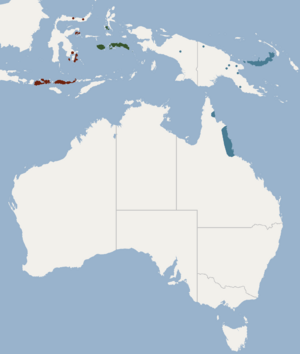Flute-nosed bat facts for kids
Quick facts for kids Flute-nosed bat |
|
|---|---|
| Conservation status | |
| Scientific classification | |
| Genus: |
Murina
|
| Species: |
florium
|
 |
|
The flute-nosed bat (Murina florium) is a special type of bat. It belongs to the vespertilionid family. This bat has a very unusual nose! Its nostrils look like tiny tubes that stick out from the end of its snout. They face outwards. These bats live in northern Queensland, Australia. You can also find them in Indonesia and Papua New Guinea.
Contents
What Does the Flute-Nosed Bat Look Like?
This bat has thick, long fur. The fur on its front is a mid-grey color. On its back, the fur is reddish or brownish-grey. Fur also covers the skin between its legs and tail.
The most unique thing about this bat is its nose. Its nostrils point away from each other. They stick out from the tip of its snout. The back edge of its ear has a small notch near the bottom. The tragus, which is a small flap in front of the ear canal, is quite small. The overall shape of its ear is round.
Size and Weight
Flute-nosed bats are not very big. Their forearm length is about 33 to 36 millimeters. Their head and body together measure 47 to 57 millimeters. The lower leg (tibia) is 31 to 37 millimeters long. Their ears are about 14 to 15 millimeters from base to tip. These bats usually weigh between 6 and 9 grams. The average weight is about 8.4 grams.
How They Fly and Communicate
The shape of their wings helps these bats fly slowly. They can even hover in the air, like a hummingbird! Some people say they can use their wings like an umbrella when they are resting. When they fly, they make a special sound. It's a long, high-pitched, loud whistle. This is how they talk to each other.
Bat Family Tree: Taxonomy
The flute-nosed bat was first described in 1908. A scientist named Oldfield Thomas wrote about it. The first bat specimen was found on Flores, one of the Sunda Islands.
Scientists have named a few different types of this bat. These are called subspecies. They are based on descriptions Thomas made in 1910 and 1923.
- species Murina florium Thomas, 1908
- subspecies Murina florium florium
- subspecies M. florium lanosa Thomas, 1910
- subspecies M. florium toxopei Thomas, 1923
This bat has a few common names. People call it the Flores tube-nosed bat. It is also known as the flute-nosed bat or the tube-nosed insectivorous bat.
Where Flute-Nosed Bats Live and What They Do
You can find these bats on many Indonesian islands. They also live in New Guinea and in the far north-eastern part of Australia. They have been seen in places like the Lesser Sunda Islands, Sulawesi, the Moluccas, Seram, and the Bismarck Archipelago near New Guinea.
In Australia, they live in the north-eastern forests. They prefer rainforests and wet sclerophyll forests. These are forests with tough, leathery leaves. They are found at heights between 200 and 1000 meters above sea level. In Australia, they live in a narrow strip along the coast. This area stretches from Shipton Flat, south of Cooktown, to the town of Paluma, Queensland.
Hunting and Resting
Flute-nosed bats often hunt for food high up in the forest trees. They also fly down to the middle parts of the trees. Their fluttering flight helps them move through the leaves. They look for food on the surfaces of plants. They eat arthropods, which are small creatures like insects and spiders.
When they are not hunting, they rest in the leaves. They might hang under a leafy branch. Sometimes, they even use bird nests! They like the nests of scrub or fernwrens, which hang from the trees.
See also
 In Spanish: Murina florium para niños
In Spanish: Murina florium para niños


